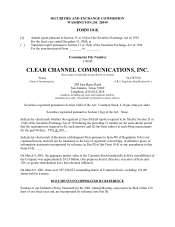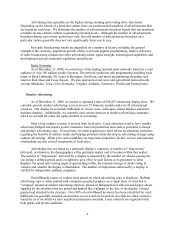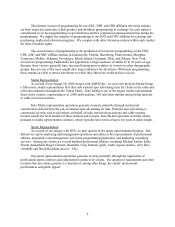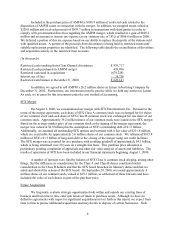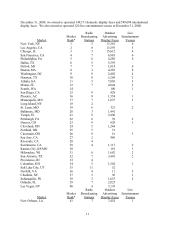iHeartMedia 2000 Annual Report Download - page 4
Download and view the complete annual report
Please find page 4 of the 2000 iHeartMedia annual report below. You can navigate through the pages in the report by either clicking on the pages listed below, or by using the keyword search tool below to find specific information within the annual report.
4
Advertising rates generally are the highest during morning and evening drive-time hours.
Depending on the format of a particular station, there are predetermined numbers of advertisements that
are broadcast each hour. We determine the number of advertisements broadcast hourly that can maximize
available revenue dollars without jeopardizing listening levels. Although the number of advertisements
broadcast during a given time period may vary, the total number of advertisements broadcast on a
particular station generally does not vary significantly from year to year.
Our radio broadcasting results are dependent on a number of factors, including the general
strength of the economy, population growth, ability to provide popular programming, relative efficiency
of radio broadcasting compared to other advertising media, signal strength, technological capabilities and
developments and governmental regulations and policies.
Radio Networks
As of December 31, 2000, we owned one of the leading national radio networks, based on a total
audience of over 180 million weekly listeners. The network syndicates talk programming including such
talent as Rush Limbaugh, Dr. Laura Schlessinger, Jim Rome, and music programming including such
talent as Rick Dees and Casey Kasem. We also operated several news and agricultural radio networks
serving Oklahoma, Texas, Iowa, Kentucky, Virginia, Alabama, Tennessee, Florida and Pennsylvania.
Outdoor Advertising
As of December 31, 2000, we owned or operated a total of 698,265 advertising display faces. We
currently provide outdoor advertising services in over 52 domestic markets and over 43 international
countries. Our display faces include billboards of various sizes, wallscapes, transit displays and street
furniture displays. Additionally, we currently own various interests in outdoor advertising companies,
which we account for under the equity method of accounting.
Most of our outdoor revenue is derived from local sales. Local advertisers tend to have smaller
advertising budgets and require greater assistance from our production and creative personnel to design
and produce advertising copy. In local sales, we often expend more sales efforts on educating customers
regarding the benefits of outdoor media and helping potential clients develop an advertising strategy using
outdoor advertising. While price and availability are important competitive factors, service and customer
relationships are also critical components of local sales.
Advertising rates are based on a particular display’ s exposure, or number of “impressions”
delivered, in relation to the demographics of the particular market and its location within that market.
The number of “impressions” delivered by a display is measured by the number of vehicles passing the
site during a defined period and is weighted to give effect to such factors as its proximity to other
displays, the speed and viewing angle of approaching traffic, the national average of adults riding in
vehicles and whether the display is illuminated. The number of impressions delivered by a display is
verified by independent auditing companies.
Our billboards consist of various sized panels on which advertising copy is displayed. Bulletin
advertising copy is either printed with computer-generated graphics on a single sheet of vinyl that is
“wrapped” around an outdoor advertising structure, placed on lithographed or silk-screened paper sheets
supplied by the advertiser that are pasted and applied like wallpaper to the face of the display, or hand
painted and attached to the structure. Over 90% of our billboard inventory has been retrofitted for vinyl.
Billboards are generally mounted on structures we ow n and are located on sites that are either owned or
leased by us or on which we have acquired a permanent easement. Lease contracts are negotiated with
both public and private landlords.

